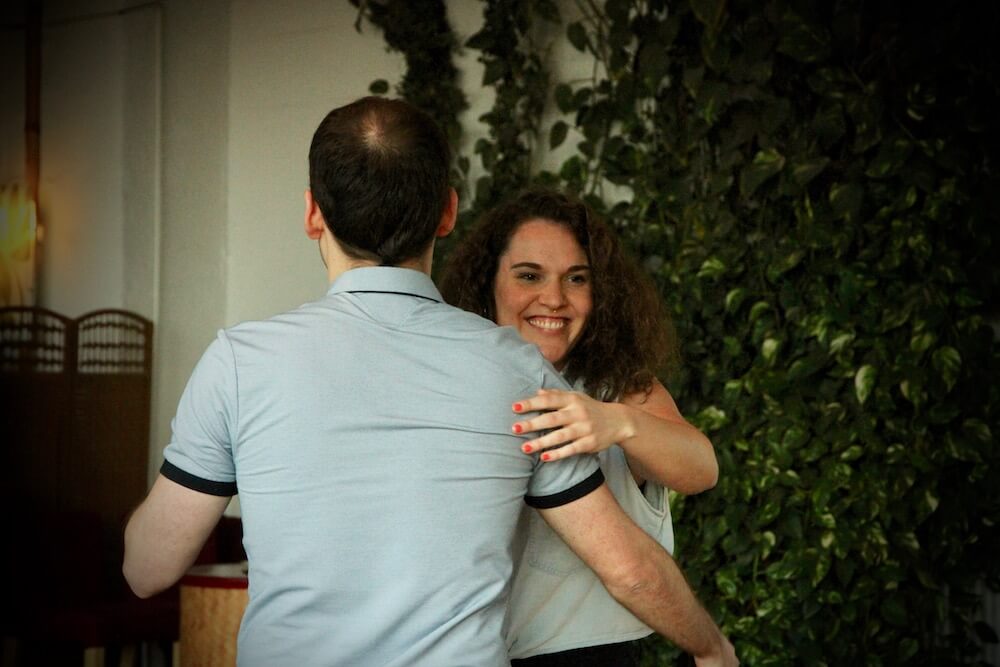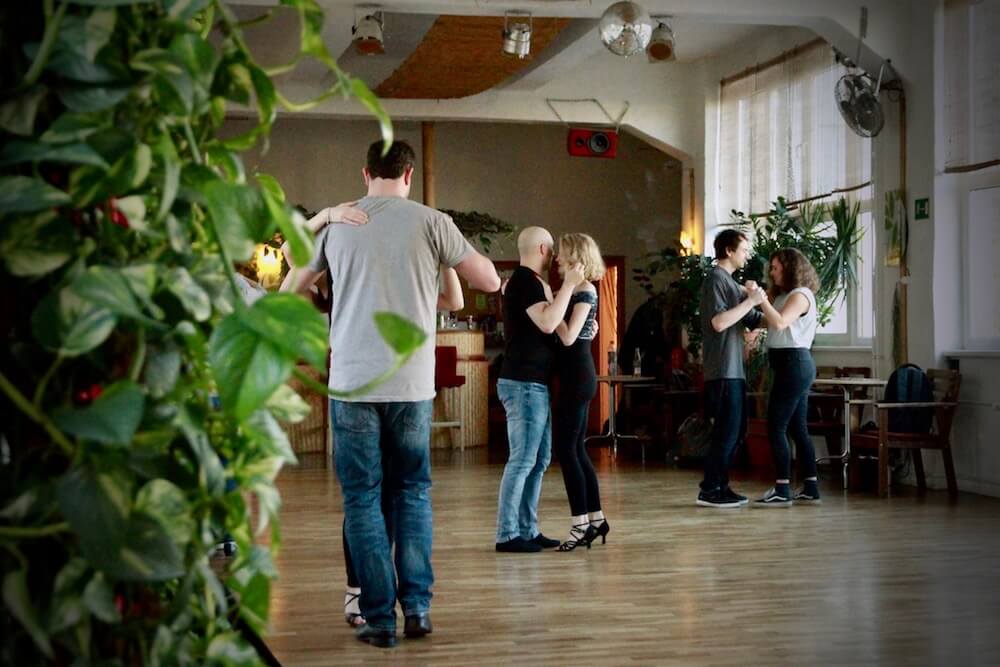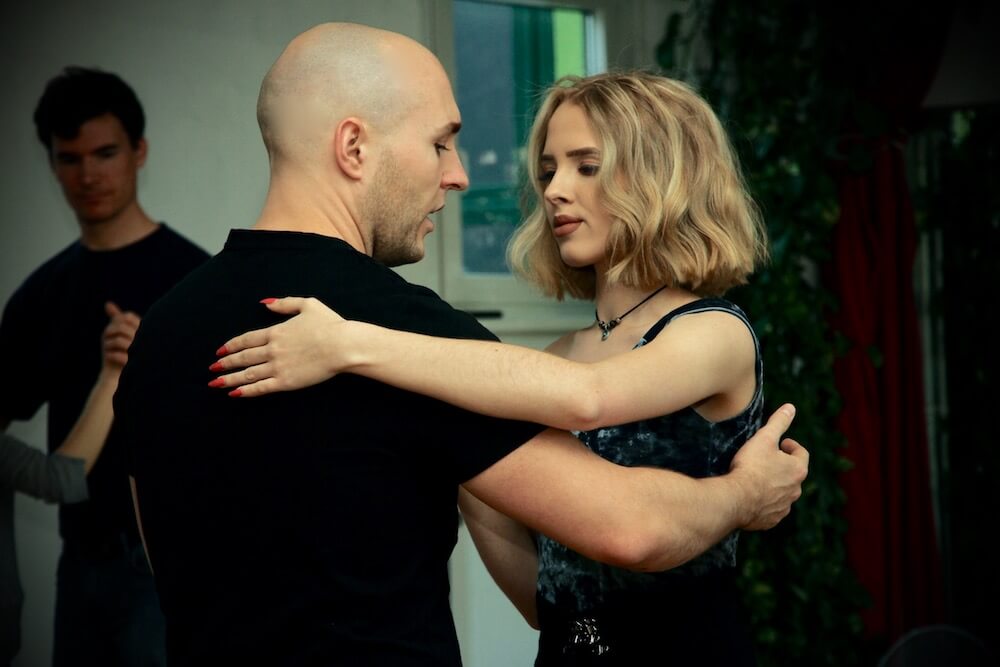
The cultural explosion of Kizomba
Every night of the week behind the closed doors of Berlin’s cafes, lofts, basements, clubs and studios you’ll find a hidden world – one that no casual passerby or map-reading tourist could ever discover without knowing where to look. This world doesn’t adhere to Berlin’s dark and moody standards; instead it explodes with the culture of Latin America, the energy of Angola, the vibrancy of The Caribbean.
Behind these doors you’ll find a space where human connections thrive, where joy, respect and movement come together. You’ll find people who aren’t afraid to challenge themselves, to learn, to grow, to be vulnerable. Behind these doors is the world of partner dance – Salsa, Kizomba, Tango, Zouk, Bachata… and I’m about to enter it.
I’m standing in La Mambita Tanz Studio in Berlin’s Kreuzberg district about to begin my first Kizomba lesson. The studio has a distinct Latin-American spirit. There’s a tiki bar where drinks and snacks can be served during one of the many social dance parties La Mambita hosts. Potted plants and palm trees are dotted around the room and an entire wall of leafy green plants behind reception makes the space half dance studio, half jungle. Sunlight streams through huge windows, their light doubled by a wall of mirrors at one end of the studio. Who could imagine that such a beautiful space lay behind the graffitied double doors of a Kreuzberg street? But, as we all know, Berlin is full of surprises and this is just one of them.
My teacher, Johannes greets me warmly as I enter. “Alice! Willkommen!” Like many dance teachers I’ve met he has an air of total self-assuredness and ease of movement. Johannes has been instrumental in teaching and building Berlin’s Kizomba scene over the last few years. A dance that many people had never heard of three years ago is now one of the largest players in Berlin’s social dance scene.

Kizomba, Angolan for ‘Party’, was first shaped in Angola and spread through the Portuguese-speaking countries of Africa throughout the 1970s and 1980s. It’s a smooth, sensuous partner dance, known for its insistent rhythms. “Kizomba is like Tango in many ways,” Johannes explains. “It has a similar frame and upper body connection; but in Kizomba each step is your own little decision. It’s not like a set of combinations – you have to actually lead and follow every single step.”
Johannes, joined today by his dance partner Anastasia, leads us through a warm-up. There’s about 12 people in the class – a great turnout for a sunny Sunday afternoon – and we all side-step in unison; a brief introduction to the basic steps of the dance. “Kizomba is one of the easier dances to learn,” Johannes explains. “In Salsa you have lots of steps to memorise, especially as a leader. But In Kizomba you just walk together. The only thing you have to learn is how to move together as a couple. A good leader can lead followers who have no history of dancing.”

Warm-up complete we partner up; this part always makes me nervous. I’m not used to being in close proximity to people that I do know, let alone total strangers. But, then again, this is the reason why many people come to partner dance classes.
“I think generally in Western society people don’t have enough physical interaction with each other,” Johannes says. “I think a lot of people come to Kizomba to feel connected to people. It’s just like animals grooming each other. It’s important to have physical contact with other members of the species. And Kizomba fills that role very well for lots of people.” This animal comparison seems slightly strange but as soon as we start dancing I understand what he means. There’s something very calming about dancing with someone else, following steps and learning together.
Johannes and Anastasia stand in the centre of the class expertly demonstrating each step and sequence. We then spend a few minutes practising with our partner, until we switch and watch the next demonstration. This means I dance with everyone in the class at least twice throughout the lesson – which, although intimidating, is the best way to learn.

It doesn’t take long for me to decide that I like Kizomba. The steps are simple and my dance partners are extremely kind and patient. Although on one occasion Johannes has to step in to help me out. “Keep your arms loose and let go of all the tension in your body,” he says. I follow his instructions as closely as possible without slumping to the floor in a heap. Then when I partner up again I find the sequence much more fluid and easier to follow.
I’m getting the hang of this I think to myself. Partner dances are often about finding a strong connection with your partner. However with Kizomba it’s possible to focus more on yourself and simply follow the steps rather than the deep, constant connection you need to maintain when dancing Salsa or Zouk.
Johannes discovered Kizomba almost by accident. “I started dancing Salsa first; then Bachata and Cha Cha and then Kizomba just randomly appeared in my peripheral vision. I was at a dance festival in 2009 in Croatia. Everyone was telling me to check out this Kizomba room. I remember thinking that sounds like nonsense – that’s just a fad that’ll go away soon. But I tried it and it stuck and ever since I’ve danced more and more Kizomba.”
It can be difficult and time-consuming to build a dance scene but Kizomba has sky-rocketed in popularity over the last few years. Johannes believes that it’s a combination of luck and hard work. “It’s lucky to find locations that are willing to support an event for a while until it gets big. Once you have the consistency of a party every week that’s when it takes off. People can come regularly, see others who dance amazingly, get inspired, come back the next week. So it just feeds off this. And then once you have people in the classes the workshops get full up, then the parties and it just snowballs from there.”
By “parties” Johannes means those hosted bi-weekly at Soda Club in Berlin’s Prenzlauer Berg. Every Sunday and Thursday you will find ginormous social dance parties. The different rooms in Soda are dedicated to different dances – Salsa, Bachata, Zouk, Tango, Kizomba – each with a DJ that plays music specific to the dance. These parties have put Berlin firmly on the global dance map and are hugely responsible for Berlin’s thriving dance scene.
“Dancing to music is one of the best things that anyone can do for their mental wellbeing,” Johannes says. And as our class comes to an end I fully empathise with what he’s saying. I began the dance class feeling nervous and withdrawn, self-conscious of my lack of ability. But as we dance our final steps I feel elated by everything I’ve learnt and boosted by the wonderful experience I’ve had with my dance partners.
As I gather up my stuff, a huge smile on my face, I ask our teacher Anastasia how she discovered Kizomba. “Two years ago my sister forced me to go with her to a class,” she tells me. “I’d never danced before and I really didn’t want to go… And Johannes was the first person I danced with.”
For a second I’m speechless. As a teacher I assumed Anastasia had been dancing for years. She must’ve had no idea of the impact that first Kizomba class would have on her life. But, as we all know, Berlin is full of surprises – you just have to know where to look.
If you’d like to try Kizomba we have tons of dance partners across Germany, Italy, France, Portugal and Spain.
Take a look at our site to see what’s on.
And check out La Mambita for a full schedule of their dance classes.



Comments